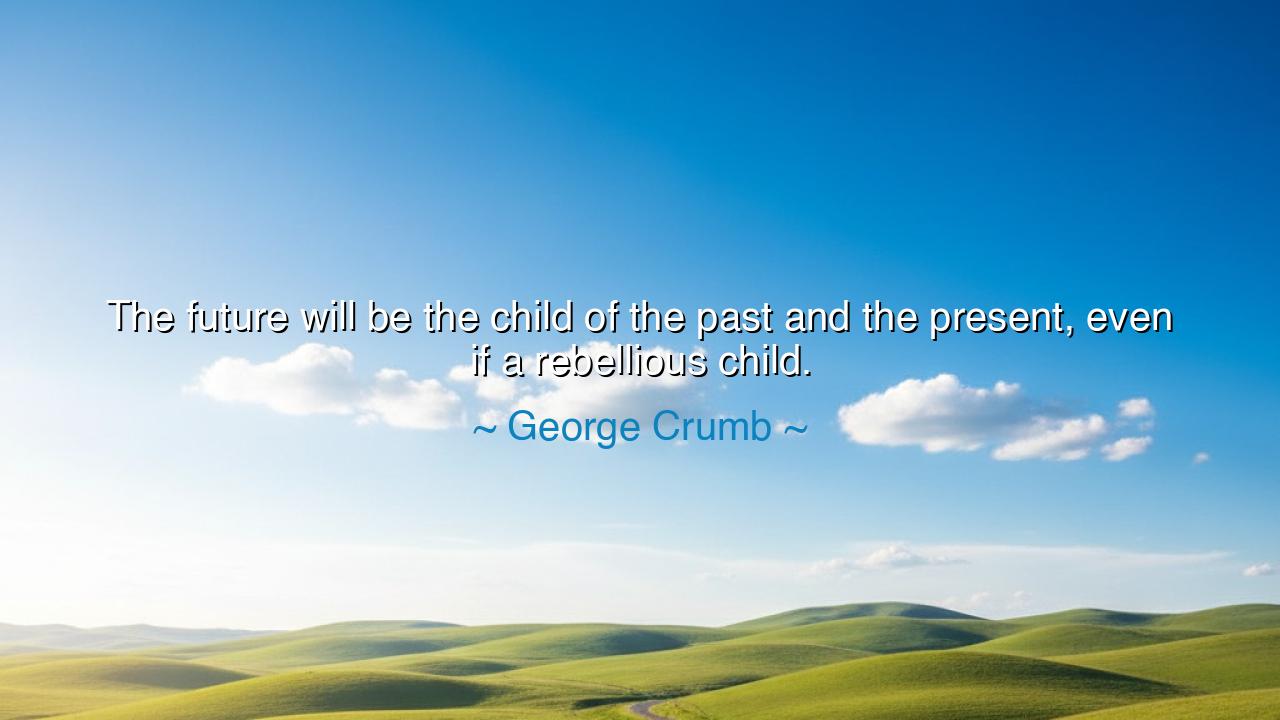
The future will be the child of the past and the present, even if






"The future will be the child of the past and the present, even if a rebellious child." These words by George Crumb offer a profound reflection on the nature of time, progress, and the interplay between what has come before and what is to come. In essence, Crumb suggests that the future is not a completely new creation but a continuation—an offspring of the past and the present. However, like any child, the future is not merely a passive inheritance of what has been, but often a rebellious force that pushes against the established norms, seeking to forge its own path. This quote is not just about the inevitable passage of time but speaks to the dynamic tension between tradition and innovation, between legacy and revolution.
In the ancient world, the relationship between past and future was not merely an intellectual consideration but a spiritual one. The Greeks often spoke of Fate, the inescapable force that shaped human lives, yet they also revered the power of the present moment to change one's destiny. In Heraclitus' teachings, we hear of constant change, that everything flows, and that the future is a movement—a force driven by the perpetual change between past and present. To Heraclitus, the future was not just something that came from nowhere; it was a child born of the eternal flow of time, shaped by the actions, beliefs, and choices of both the past and the present.
The Romans also understood this relationship between past, present, and future, though they viewed it through the lens of virtue and legacy. The Romans believed that the virtues of ancestors were passed down through generations and that the future greatness of the state depended on honoring the traditions of the past. Yet, in the era of Julius Caesar, rebellion and change were in the air. Caesar himself was a figure who represented both the continuity of Roman tradition and the birth of a new political world. He was the child of Rome’s rich history, but he was also a rebellious force, challenging the existing system and leading to a transformation that would forever alter the course of Roman history. Caesar, much like the rebellious child Crumb describes, was both the heir to a tradition and the architect of a new future.
Consider the story of Martin Luther, whose act of nailing his 95 Theses to the church door in 1517 was both a reflection of centuries of Christian tradition and a powerful act of rebellion. Luther did not reject the past outright; instead, he sought to reform the Catholic Church from within, pushing for changes that would lead to the Protestant Reformation. The Reformation was, in many ways, the child of the church’s history, but also a rebellious force, challenging centuries of established dogma and leading to the birth of new forms of worship and theological thought. Luther’s rebellion was not against the past itself but against the way it had been interpreted, showing that the future, though shaped by tradition, can also push back and redefine it.
This dynamic tension between the past and the future is not limited to historical events or revolutions; it is present in every individual’s journey. The ancient Buddhists spoke of the impermanence of life, emphasizing that while we are shaped by our past, we have the power to create our own future. Just as the future is born from the present, so too is each individual shaped by the choices they make, not just by the legacies of their ancestors. The past may offer wisdom and tradition, but the future, like a rebellious child, often rises from the present to question, transform, and make its own mark.
The lesson Crumb imparts is that we must acknowledge the influence of the past, but we must not be enslaved by it. Progress is often born from rebellion—from the desire to break free from the constraints of what has been and create something new. This does not mean rejecting the past; rather, it means transforming it, learning from it, and allowing it to serve as the foundation upon which the future is built. Just as the great thinkers, artists, and leaders of the past did not simply follow tradition but reimagined it, so too must we take the lessons of our ancestors and use them as stepping stones to create a future that reflects our evolving values and aspirations.
In practical terms, we can take action today by examining our relationship with both the past and the future. Are we too bound by tradition, afraid to step outside the lines and create something new? Or are we fully embracing the present moment, using the wisdom of the past to forge a future that reflects our unique vision? Like Crumb’s rebellious child, we must respect the foundations laid by those before us, but we must also have the courage to challenge the status quo and redefine the future on our terms. Let the future be the child of the past, but one that carries within it the potential for transformation, growth, and renewal.






AAdministratorAdministrator
Welcome, honored guests. Please leave a comment, we will respond soon